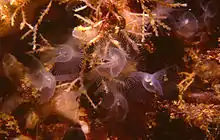Phoronis
Phoronis is one of the two genera of the horseshoe worm family (Phoronidae), in the phylum Phoronida. The body has two sections, each with its own coelom. There is a specialist feeding structure, the lophophore, which is an extension of the wall of the coelom and is surrounded by tentacles. The gut is U-shaped. The diagnostic feature that distinguishes this genus is the lack of epidermal invagination at the base of the lophophore. These worms are filter feeders.[1]
| Phoronis | |
|---|---|
 | |
| Phoronis hippocrepia | |
| Scientific classification | |
| Kingdom: | Animalia |
| Clade: | Lophophorata |
| Phylum: | Phoronida |
| Family: | Phoronidae |
| Genus: | Phoronis Wright 1856 |
| Type species | |
| Phoronis ovalis Wright 1856 | |
| Species | |
|
see text | |
| Synonyms | |
| |
The scientific name of the larval form is Actinotrocha.
Etymology
The generic name refers to Phoronis (better known as Io), a Greek mythological character sometimes conflated with Isis.[2] Thomas Strethill Wright, of Edinburgh, did not give a specific reason for choosing the name.[3]
Species
- Phoronis australis Haswell 1883
- Phoronis embryolabi Temereva & Chichvarkhin, 2017
- Phoronis emigi Hirose et al. 2014
- Phoronis hippocrepia Wright 1856
- Phoronis ijimai Oka 1897
- Phoronis muelleri Selys-Lonchamps 1903
- Phoronis ovalis Wright 1856
- Phoronis pallida (Schneider 1862) Silén 1952
- Phoronis psammophila Cori 1889[4]
- Phoronis savinkini Temereva & Neklyudov, 2018
Phoronis architecta is no longer accepted and is considered to be a synonym of Phoronis psammophila. Similarly Phoronis vancouverensis is considered to be a synonym of Phoronis ijimai.[5]
A 2018 phylogenetic analysis indicates that Phoronis is paraphyletic, while Phoronopsis is a monophyletic genus.[6]
References
- Phoronida
- "Phoronis". Merriam-Webster Dictionary. "New Latin, probably from Latin Phoronis (Io, mythical priestess of Argos who was loved by Zeus)."
- Strethill Wright, T. (1856). "Description of Two Tubicolar Animals". The Edinburgh New Philosophical Journal. Edinburgh. 4 (new ser.): 316.
[The entire footnote:] Phoronis, one of the surnames of Isis.
- World Register of Marine Species
- ITIS
- Temereva, E. N.; Neklyudov, B. V. (2018). A New Phoronid Species, Phoronis savinkini sp. n., from the South China Sea and an Analysis of the Taxonomic Diversity of Phoronida. Biology Bulletin. 45(7): 617-639. doi:10.1134/s1062359018070154